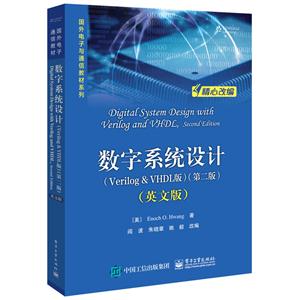預(yù)估到手價(jià)是按參與促銷活動(dòng)、以最優(yōu)惠的購(gòu)買方案計(jì)算出的價(jià)格(不含優(yōu)惠券部分),僅供參考,未必等同于實(shí)際到手價(jià)。
-
>
闖進(jìn)數(shù)學(xué)世界――探秘歷史名題
-
>
中醫(yī)基礎(chǔ)理論
-
>
當(dāng)代中國(guó)政府與政治(新編21世紀(jì)公共管理系列教材)
-
>
高校軍事課教程
-
>
思想道德與法治(2021年版)
-
>
毛澤東思想和中國(guó)特色社會(huì)主義理論體系概論(2021年版)
-
>
中醫(yī)內(nèi)科學(xué)·全國(guó)中醫(yī)藥行業(yè)高等教育“十四五”規(guī)劃教材
數(shù)字系統(tǒng)設(shè)計(jì):Verilog & VHDL版:英文版 版權(quán)信息
- ISBN:9787121334214
- 條形碼:9787121334214 ; 978-7-121-33421-4
- 裝幀:一般膠版紙
- 冊(cè)數(shù):暫無(wú)
- 重量:暫無(wú)
- 所屬分類:>>
數(shù)字系統(tǒng)設(shè)計(jì):Verilog & VHDL版:英文版 本書特色
隨著微電子技術(shù)與計(jì)算機(jī)技術(shù)的飛速發(fā)展,以及先進(jìn)的電子設(shè)計(jì)自動(dòng)化(EDA)技術(shù)及現(xiàn)場(chǎng)可編程門陣列(FPGA)器件的廣泛應(yīng)用,現(xiàn)代數(shù)字邏輯電路與系統(tǒng)的設(shè)計(jì)理念及實(shí)現(xiàn)技術(shù)已經(jīng)發(fā)生了翻天覆地的變化。本書以微處理器系統(tǒng)作為復(fù)雜數(shù)字邏輯系統(tǒng)的代表,在簡(jiǎn)要介紹其工作原理的基礎(chǔ)上,以CPU硬件結(jié)構(gòu)框圖為線索貫穿各個(gè)章節(jié),詳細(xì)講述了如何構(gòu)建基本組合/時(shí)序邏輯元件、如何利用已有元件組建數(shù)據(jù)通路與控制單元部件、如何利用已有部件實(shí)現(xiàn)一個(gè)通用CPU,以及如何通過(guò)進(jìn)一步添加簡(jiǎn)單的輸入輸出接口來(lái)*終搭建出一個(gè)完整的微處理器系統(tǒng)。本書通過(guò)在簡(jiǎn)單的數(shù)字邏輯元件與復(fù)雜的實(shí)用數(shù)字邏輯系統(tǒng)之間搭建橋梁,能夠幫助讀者深刻理解數(shù)字邏輯組件的設(shè)計(jì)與使用方法,進(jìn)而全面和清晰地把握復(fù)雜數(shù)字系統(tǒng)的EDA設(shè)計(jì)與實(shí)現(xiàn)技術(shù)要點(diǎn)。本書及相關(guān)網(wǎng)站提供了豐富的實(shí)用學(xué)習(xí)資源,所有設(shè)計(jì)示例都提供了電路圖以及Verilog與VHDL源碼。
數(shù)字系統(tǒng)設(shè)計(jì):Verilog & VHDL版:英文版 內(nèi)容簡(jiǎn)介
本書通過(guò)在簡(jiǎn)單的數(shù)字邏輯元件與復(fù)雜的實(shí)用數(shù)字邏輯系統(tǒng)之間搭建橋梁,能夠幫助讀者深刻理解數(shù)字邏輯組件的設(shè)計(jì)與使用方法,進(jìn)而全面和清晰地把握復(fù)雜數(shù)字系統(tǒng)的EDA設(shè)計(jì)與實(shí)現(xiàn)技術(shù)要點(diǎn)。本書及相關(guān)網(wǎng)站提供了豐富的實(shí)用學(xué)習(xí)資源,所有設(shè)計(jì)示例都提供了電路圖以及Verilog與VHDL源碼。
數(shù)字系統(tǒng)設(shè)計(jì):Verilog & VHDL版:英文版 目錄
1.1 Overview of Microprocessor Design
1.2 Design Abstraction Levels
1.3 Examples of a 2-to-1 Multiplexer
1.3.1 Behavioral Level
1.3.2 Gate Level
1.3.3 Transistor Level
1.4 Introduction to Hardware Description Language
1.5 Synthesis
1.6 Going Forward
1.7 Problems
Chapter 2 Fundamentals of Digital Circuits
2.1 Binary Numbers
2.1.1 Counting in Binary
2.1.2 Converting between Binary and Decimal
2.1.3 Octal and Hexadecimal Notations
2.1.4 Binary Number Arithmetic
2.2 Negative Numbers
2.2.1 Two’s Complement Representation
2.2.2 Sign Extension
2.2.3 Signed Number Arithmetic
2.3 Binary Switch
2.4 Basic Logic Operators and Logic Expressions
2.5 Logic Gates
2.6 Truth Tables
2.7 Boolean Algebra and Boolean Equations
2.7.1 Boolean Algebra
2.7.2 Duality Principle
2.7.3 Boolean Functions and Their Inverses
2.8 Minterms and Maxterms
2.8.1 Minterms
2.8.2 Maxterms
2.9 Canonical, Standard, and Non-Standard Forms
2.10 Digital Circuits
2.11 Designing a Car Security System
2.12 Verilog and VHDL Code for Digital Circuits
2.12.1 Verilog Code for a Boolean Function
2.12.2 VHDL Code for a Boolean Function
2.13 Problems
Chapter 3 Combinational Circuits 65
3.1 Analysis of Combinational Circuits
3.1.1 Using a Truth Table
3.1.2 Using a Boolean Function
3.2 Synthesis of Combinational Circuits
3.2.1 Using Only NAND Gates
3.3 Minimization of Combinational Circuits
3.3.1 Boolean Algebra
3.3.2 Karnaugh Maps
3.3.3 Don’t-Cares
3.3.4 Tabulation Method
3.4 Timing Hazards and Glitches
3.4.1 Using Glitches
3.5 BCD to 7-Segment Decoder
3.6 Verilog and VHDL Code for Combinational Circuits
3.6.1 Structural Verilog Code
3.6.2 Structural VHDL Code
3.6.3 Dataflow Verilog Code
3.6.4 Dataflow VHDL Code
3.6.5 Behavioral Verilog Code
3.6.6 Behavioral VHDL Code
3.7 Problems
Chapter 4 Standard Combinational Components
4.1 Signal Naming Conventions
4.2 Multiplexer
4.3 Adder
4.3.1 Full Adder
4.3.2 Ripple-Carry Adder
4.3.3 Carry-Lookahead Adder
4.4 Subtractor
4.5 Adder-Subtractor Combination
4.6 Arithmetic Logic Unit
4.7 Decoder
4.8 Tri-State Buffer
4.9 Comparator
4.10 Shifter
4.11 Multiplier
4.12 Problems
Chapter 5 Sequential Circuits
5.1 Bistable Element
5.2 SR Latch
5.3 Car Security System—Version 2
5.4 SR Latch with Enable
5.5 D Latch
5.6 D Latch with Enable
5.7 Verilog and VHDL Code for Memory Elements
5.7.1 VHDL Code for a D Latch with Enable
5.7.2 Verilog Code for a D Latch with Enable
5.8 Clock
5.9 D Flip-Flop
5.9.1 Alternative Smaller Circuit
5.10 D Flip-Flop with Enable
5.10.1 Asynchronous Inputs
5.11 Description of a Flip-Flop
5.11.1 Characteristic Table
5.11.2 Characteristic Equation
5.11.3 State Diagram
5.12 Register
5.13 Register File
5.14 Memories
5.14.1 ROM
5.14.2 RAM
5.15 Shift Registers
5.15.1 Serial-to-Parallel Shift Register
5.15.2 Serial-to-Parallel and Parallel-to-Serial Shift Register
5.15.3 Linear Feedback Shift Register
5.16 Counters
5.16.1 Binary Up Counter
5.16.2 Binary Up Counter with Parallel Load
5.17 Timing Issues
5.18 Problems
Chapter 6 Finite-State Machines
6.1 Finite-State Machine Models
6.2 State Diagrams
6.3 Analysis of Finite-State Machines
6.3.1 Next-State Equations
6.3.2 Next-State Table
6.3.3 Output Equations
6.3.4 Output Table
6.3.5 State Diagram
6.3.6 Example
6.4 Synthesis of Finite-State Machines
6.4.1 State Diagram
6.4.2 Next-State Table
6.4.3 Next-State Equations
6.4.4 Output Table and Output Equations
6.4.5 FSM Circuit
6.5 Optimizations for FSMs
6.5.1 State Reduction
6.5.2 State Encoding
6.5.3 Unused States
6.6 FSM Construction Examples
6.6.1 Car Security System—Version 3
6.6.2 Modulo-6 Up-Counter
6.6.3 One-Shot Circuit
6.6.4 Simple Microprocessor Control Unit
6.6.5 Elevator Controller Using a Moore FSM
6.6.6 Elevator Controller Using a Mealy FSM
6.7 Verilog and VHDL Code for FSM Circuits
6.7.1 Behavioral Verilog Code for a Moore FSM
6.7.2 Behavioral Verilog Code for a Mealy FSM
6.7.3 Behavioral VHDL Code for a Moore FSM
6.7.4 Behavioral VHDL Code for a Mealy FSM
6.8 Problems
Chapter 7 Dedicated Microprocessors
7.1 Need for a Datapath
7.2 Constructing the Datapath
7.2.1 Selecting Registers
7.2.2 Selecting Functional Units
7.2.3 Data Transfer Methods
7.2.4 Generating Status Signals
7.3 Constructing the Control Unit
7.3.1 Deriving the Control Signals
7.3.2 Deriving the State Diagram
7.3.3 Timing Issues
7.3.4 Deriving the FSM Circuit
7.4 Constructing the Complete Microprocessor
7.5 Dedicated Microprocessor Construction Examples
7.5.1 Greatest Common Divisor
7.5.2 High-Low Number Guessing Game
7.5.3 Traffic Light Controller
7.6 Verilog and VHDL Code for Dedicated Microprocessors
7.6.1 FSM1D Model
7.6.2 FSMD Model
7.6.3 Algorithmic Model
7.7 Problems
Chapter 8 General-Purpose Microprocessors
8.1 Overview of the CPU Design
8.2 The EC-1 General-Purpose Microprocessor
8.2.1 Instruction Set
8.2.2 Datapath
8.2.3 Control Unit
8.2.4 Complete Circuit
8.2.5 Sample Program
8.2.6 Simulation
8.2.7 Hardware Implementation
8.3 The EC-2 General-Purpose Microprocessor
8.3.1 Instruction Set
8.3.2 Datapath
8.3.3 Control Unit
8.3.4 Complete Circuit
8.3.5 Sample Program
8.3.6 Hardware Implementation
8.4 Extending the EC-2 Instruction Set
Chapter 9 Interfacing Microprocessors
9.1 Multiplexing 7-Segment LED Display
9.1.1 Theory of Operation
9.1.2 Controller Design
9.2 Issues with Interfacing Switches
9.3 3×4 Keypad Controller
9.3.1 Theory of Operation
9.3.2 Controller Design
數(shù)字系統(tǒng)設(shè)計(jì):Verilog & VHDL版:英文版 作者簡(jiǎn)介
Enoch O. Hwang 于美國(guó)加州大學(xué)Riverside分校獲計(jì)算機(jī)科學(xué)博士學(xué)位,目前是南加州Sierra大學(xué)計(jì)算機(jī)科學(xué)系助理教授,加州大學(xué)Riverside分校電子工程系、計(jì)算機(jī)科學(xué)與工程系講師,主要講授數(shù)字邏輯設(shè)計(jì)課程。
Enoch O. Hwang 于美國(guó)加州大學(xué)Riverside分校獲計(jì)算機(jī)科學(xué)博士學(xué)位,目前是南加州Sierra大學(xué)計(jì)算機(jī)科學(xué)系助理教授,加州大學(xué)Riverside分校電子工程系、計(jì)算機(jī)科學(xué)與工程系講師,主要講授數(shù)字邏輯設(shè)計(jì)課程。
- >
伊索寓言-世界文學(xué)名著典藏-全譯本
- >
經(jīng)典常談
- >
名家?guī)阕x魯迅:故事新編
- >
人文閱讀與收藏·良友文學(xué)叢書:一天的工作
- >
有舍有得是人生
- >
我與地壇
- >
姑媽的寶刀
- >
李白與唐代文化















